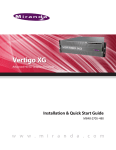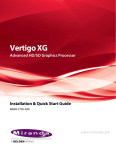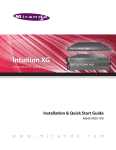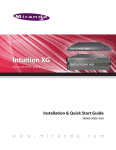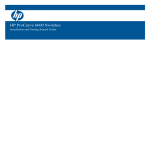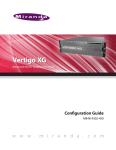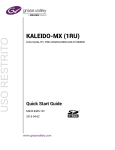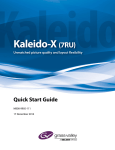Download Miranda Vertigo XG Operating instructions
Transcript
Vertigo XG Advanced HD/SD Graphics Processor Installation and Quick Start Guide M848-2705-500 Copyright & Trademark Notice Copyright © 2015, Grass Valley USA, LLC. All rights reserved. Belden, Belden Sending All The Right Signals, and the Belden logo are trademarks or registered trademarks of Belden Inc. or its affiliated companies in the United States and other jurisdictions. Grass Valley USA, LLC, Miranda, Vertigo Suite, Vertigo XG and Xmedia Server are trademarks or registered trademarks of Grass Valley USA, LLC. Belden Inc., Grass Valley USA, LLC, and other parties may also have trademark rights in other terms used herein. Terms and Conditions Please read the following terms and conditions carefully. By using the Vertigo XG documentation, you agree to the following terms and conditions. Grass Valley hereby grants permission and license to owners of the Vertigo XG to use their product manuals for their own internal business use. Manuals for Grass Valley, A Belden Brand products may not be reproduced or transmitted in any form or by any means, electronic or mechanical, including photocopying and recording, for any purpose unless specifically authorized in writing by Grass Valley. A Grass Valley manual may have been revised to reflect changes made to the product during its manufacturing life. Thus, different versions of a manual may exist for any given product. Care should be taken to ensure that one obtains the proper manual version for a specific product serial number. Information in this document is subject to change without notice and does not represent a commitment on the part of Grass Valley. Warranty Policies Warranty information is available in the Support section of the Grass Valley Web site (www.grassvalley.com). Document Identification Title Vertigo XG - Installation & Quick Start Guide Part number M848-2705-500 SW version Vertigo Suite v5.0 Revision History After the original release date, this document may be updated with edits and then rereleased. The following table tracks the versions of this document. Revision date Description November 28, 2014 Original release March 02, 2015 Vertigo Suite v5.0 SP1 release Safety Compliance This equipment complies with the requirements of CSA/UL/IEC/EN 60950-1, 2nd Ed. + AM1, Safety of information technology equipment. The power cords supplied with this equipment meet the appropriate national standards for the country of destination. [fr] Conformité aux normes de sécurité Cet équipement est conforme aux exigences de CSA/UL/IEC/EN 60950-1, 2e éd. + AM1, Sécurité du matériel informatique. Les cordons d'alimentation fournis avec l’appareil répondent aux normes nationales appropriées du pays destinataire. [es] Conformidad en seguridad eléctrica Este equipo cumple con las exigencias de la CSA/UL/IEC/EN 60950-1, 2a ed. + AM1, Seguridad de los equipos de tecnología de la información. Los cables de alimentación incluidos con el equipo cumplen con las normas nacionales apropiadas para el país de destino. [pt] Conformidade de segurança elétrica Este equipamento está em conformidade com os requisitos da CSA/UL/IEC/EN 60950-1, 2a ed. + AM1, Segurança de equipamento de tecnologia da informação. Os cabos de alimentação fornecidos com este equipamento encontram as normas nacionais adequadas para o país de destino. Safety of Laser Modules This equipment incorporates modules containing Class 1 lasers. These modules are certified by the manufacturer to comply with: • IEC/EN 60825-1 Safety of laser products • IEC 60950-1 Safety of information technology equipment [fr] Sécurité laser L’appareil comprend des modules laser de classe 1. Ces modules sont certifiés conformes aux normes suivantes par le fabricant : • IEC/EN 60825-1 Sécurité des appareils à laser • IEC 60950-1 Sécurité du matériel informatique [es] Seguridad por los módulos laser Este equipo incorpora módulos láser de la Clase 1 Estos módulos están certificados por el fabricante para cumplir con: • IEC/EN 60825-1 Seguridad de los productos láser • IEC 60950-1 Seguridad de los equipos de tecnología de la información [pt] Segurança por módulo de laser Este equipamento incorpora módulos que contêm laser da classe 1. Estes módulos são certificados pelo fabricante em conformidade com: • IEC/EN 60825-1 Segurança de equipamentos laser • IEC 60950-1 Segurança de equipamento de tecnologia da informação Important Safeguards and Notices This section provides important safety guidelines for operators and service personnel. Specific warnings and cautions appear throughout the manual where they apply. Please read and follow this important information, especially those instructions related to the risk of electric shock or injury to persons. [fr] Mesures de sécurité et avis importants La présente section fournit des consignes de sécurité importantes pour les opérateurs et le personnel de service. Des avertissements ou mises en garde spécifiques figurent dans le manuel, dans les sections où ils s’appliquent. Prenez le temps de bien lire les consignes et assurez-vous de les respecter, en particulier celles qui sont destinées à prévenir les décharges électriques ou les blessures. [es] Medidas de seguridad y avisos importantes Esta sección proporciona pautas de seguridad importantes para los operadores y el personal de servicio. Advertencias y precauciones específicas aparecen en el manual para su aplicación. Por favor, lea y siga esta importante información, especialmente aquellas instrucciones relacionadas con el riesgo de descarga eléctrica o lesiones a las personas. [pt] Salvaguardas e avisos importantes Esta seção fornece diretrizes de segurança importantes para os operadores e pessoal de serviço. Avisos e cuidados específicos estão listados no manual para sua aplicação. Por favor, leia e siga esta informação importante, especialmente aquelas instruções relacionadas ao risco de choque elétrico ou ferimentos. Symbols and Their Meanings The lightning flash with arrowhead symbol within an equilateral triangle alerts the user to the presence of dangerous voltages within the product’s enclosure that may be of sufficient magnitude to constitute a risk of electric shock to persons. The exclamation point within an equilateral triangle alerts the user to the presence of important operating and maintenance/service instructions. The earth ground symbol represents a protective grounding terminal. Such a terminal must be connected to earth ground prior to making any other connections to the equipment. The fuse symbol indicates that the fuse referenced in the text must be replaced with one having the ratings indicated. The presence of this symbol in or on Grass Valley, A Belden Brand equipment means that it has been designed, tested and certified as complying with applicable Canadian Standard Association (CSA) regulations and recommendations for USA/Canada. The presence of this symbol in or on Grass Valley, A Belden Brand equipment means that it has been designed, tested and certified as complying with applicable Underwriters Laboratory (UL) regulations and recommendations for USA/Canada. The presence of this symbol in or on Grass Valley, A Belden Brand equipment means that it has been designed, tested and certified as essentially complying with all applicable European Union (CE) directives. The presence of this symbol in or on Grass Valley, A Belden Brand product means that it complies with safety of laser product applicable standards. Warnings A warning indicates a possible hazard to personnel, which may cause injury or death. Observe the following general warnings when using or working on this equipment: • Appropriately listed/certified mains supply power cords must be used for the connection of the equipment to the mains voltage at either 120 V AC or 240 V AC. • This product relies on the building's installation for short-circuit (over-current) protection. Ensure that a fuse or circuit breaker for 120 V AC or 240 V AC is used on the phase conductors. • Any instructions in this manual that require opening the equipment cover or enclosure are for use by qualified service personnel only. • Heed all warnings on the unit and in the operating instructions. • Do not use this equipment in or near water. • This equipment is grounded through the grounding conductor of the power cords. To avoid electrical shock, plug the power cords into a properly wired receptacle before connecting the equipment inputs or outputs. • Route power cords and other cables so they are not likely to be damaged. • Disconnect power before cleaning the equipment. Do not use liquid or aerosol cleaners; use only a damp cloth. • Dangerous voltages may exist at several points in this equipment. To avoid injury, do not touch exposed connections and components while power is on. • Do not wear rings or wristwatches when troubleshooting high current circuits such as the power supplies. • To avoid fire hazard, use only the specified fuses with the correct type number, voltage and current ratings as referenced in the appropriate locations in the service instructions or on the equipment. Always refer fuse replacements to qualified service personnel. • To avoid explosion, do not operate this equipment in an explosive atmosphere. • This product includes a backup battery. There is a danger of explosion if the battery is replaced incorrectly. Replace the battery only with the same or equivalent type recommended by the manufacturer. Dispose of used batteries according to the manufacturer’s instructions. • Have qualified service personnel perform safety checks after any service. [fr] Avertissements • Un cordon d’alimentation dûment homologué doit être utilisé pour connecter l’appareil à une tension de secteur de 120 V CA ou 240 V CA. • La protection de ce produit contre les courts-circuits (surintensités) dépend de l’installation électrique du bâtiment. Assurez-vous qu'un fusible ou un disjoncteur pour 120 V CA ou 240 V CA est utilisé sur les conducteurs de phase. • Dans le présent manuel, toutes les instructions qui nécessitent d’ouvrir le couvercle de l’équipement sont destinées exclusivement au personnel technique qualifié. • Respectez tous les avertissements figurant sur l’appareil et dans les instructions d’utilisation. • Ne pas utiliser cet appareil dans l’eau ou à proximité d’un point d’eau. • Cet équipement est mis à la terre par le conducteur de mise à la terre des cordons d’alimentation. Pour éviter les chocs électriques, branchez les cordons d’alimentation sur une prise correctement câblée avant de brancher les entrées et sorties de l’équipement. • Acheminez les cordons d’alimentation et autres câbles de façon à ce qu’ils ne risquent pas d’être endommagés. • Coupez l’alimentation avant de nettoyer l’équipement. Ne pas utiliser de nettoyants liquides ou en aérosol. Utilisez uniquement un chiffon humide. • Des tensions dangereuses peuvent exister en plusieurs points dans cet équipement. Pour éviter toute blessure, ne touchez pas aux connexions ou aux composants exposés lorsque l’appareil est sous tension. • Avant de procéder à toute opération d’entretien ou de dépannage visant des circuits à courant élevé (e.g., les blocs d’alimentation), enlevez tous vos bijoux (notamment vos bagues et votre montre). • Pour éviter tout risque d’incendie, utilisez uniquement les fusibles du type et du calibre indiqués dans la documentation ou sur l’équipement. Confiez le remplacement de fusibles au personnel technique qualifié. • Ne pas utiliser cet appareil dans une atmosphère explosive. • L’appareil renferme une pile. Pour réduire le risque d’explosion, vérifiez la polarité et ne remplacez la pile que par une pile du même type, recommandée par le fabricant. Mettez les piles usagées au rebut conformément aux directives du fabricant. • Après tout travail d’entretien ou de réparation, faites effectuer des contrôles de sécurité par le personnel technique qualifié. [es] Advertencias • Un cable de alimentación aprobado deberá ser utilizado para la conexión del equipo a la tensión de red de 120 V CA o 240 V CA. • Este producto depende de la instalación del edificio para la protección de cortocircuitos (sobre-corriente). Asegúrese que un fusible o un interruptor térmico de 120 V CA o 240 V CA se utiliza en los conductores de fase. • Todas las instrucciones de este manual que requieren abrir la tapa del equipo se llevará a cabo por personal técnico calificado. • Respete todas las advertencias en el equipo y las instrucciones de funcionamiento. • No utilice este producto en el agua o cerca de este. • Este equipo está conectado a tierra a través del conductor de puesta a tierra de los cables de alimentación. Para evitar una descarga eléctrica, enchufe el cable de alimentación a un tomacorriente debidamente instalado antes de conectar las entradas y salidas del equipo. • Instale los cables de alimentación y otros cables de forma de evitar ser dañados. • Desconecte la alimentación antes de limpiar el equipo. No use limpiadores líquidos o aerosoles, utilizar un paño húmedo. • Pueden existir tensiones peligrosas en varios puntos de este equipo. Para evitar lesiones, no toque las conexiones y componentes expuestos cuando la unidad está con alimentación. • No use anillos o relojes al solucionar problemas de circuitos de alta corriente como fuentes de alimentación. • Para evitar el riesgo de incendios, utilice sólo el fusible indicado con el número de tipo correcto, el voltaje y la corriente que se hace referencia en los lugares apropiados en las instrucciones de los servicios o el equipo. Siempre consulte el reemplazo del fusible a personal calificado. • Para evitar explosiones, no utilice este equipo en una atmósfera explosiva. • Este producto incluye una batería de reserva. Existe el peligro de explosión si la batería se instala de forma incorrecta. Reemplace la batería únicamente con el mismo tipo o equivalente recomendada por el fabricante. Deshágase de las baterías usadas según las instrucciones del fabricante. • Deje al personal calificado realizar las verificaciones de seguridad después de un servicio. [pt] Advertências • Um cabo de alimentação aprovado deve ser utilizado para ligar o equipamento à tensão da rede de 120 V CA ou 240 V CA. • Este produto baseia-se na instalação do edifício para proteção por curto-circuito (sobrecarga de corrente). Certifique-se de que um fusível ou disjuntor para 120 V CA ou 240 V CA é utilizado nos condutores de fase. • Todas as instruções contidas neste manual, que exigem a abertura da tampa do equipamento será realizada por pessoal qualificado. • Preste atenção a todos os avisos no equipamento e instruções de operação. • Não use este produto em ou perto da água. • Este equipamento é aterrado através do condutor de aterramento do cabo de alimentação. Para evitar choque elétrico, conecte o cabo de alimentação a uma tomada devidamente instalada antes de ligar as entradas e saídas do dispositivo. • Instale os cabos de alimentação e os outros cabos de modo a evitar danos. • Desligue a alimentação antes de limpar o equipamento. Não use detergentes líquidos ou aerossóis, usar um pano úmido. • Tensões perigosas podem existir em vários pontos deste equipamento. Para evitar ferimentos, não toque as conexões e componentes expostos quando o aparelho está ligado. • Não usar anéis ou relógios ao solucionar problemas de circuitos de alta tensão, tais como fontes de alimentação. • Para evitar o risco de incêndio, utilize apenas o número especificado de fusível de tipo correto de tensão e corrente a que se refere o manual de serviço adequado. Referemse sempre trocar o fusível por pessoal qualificado. • Para evitar a explosão, não utilize este equipamento em uma atmosfera explosiva. • Este produto inclui uma bateria de backup. Existe o perigo de explosão se a bateria está instalada incorretamente. Substitua a bateria somente com o mesmo tipo ou equivalente recomendado pelo fabricante. Elimine as baterias usadas de acordo com as instruções do fabricante. • Deixe o pessoal qualificado executar verificações de segurança depois de um serviço. Cautions A caution indicates a possible hazard to equipment that could result in equipment damage. Observe the following cautions when operating or working on this equipment: • This equipment is meant to be installed in a restricted access location. • When installing this equipment, do not attach the power cord to building surfaces. • To reduce the risk of electric shock, do not perform any servicing other than that contained in the operating instructions unless you are qualified to do so. Refer all servicing to qualified service personnel. Servicing should be done in a static-free environment. • This unit has more than one power supply cord. Disconnect both power supply cords before servicing to avoid electric shock. • To prevent damage to equipment when replacing fuses, locate and correct the problem that caused the fuse to blow before re-applying power. • Use only the specified replacement parts. • Follow static precautions at all times when handling this equipment. • Products that have no on/off switch, and use an external power supply must be installed in proximity to a main power outlet that is easily accessible. [fr] Mises en garde • L’appareil est conçu pour être installé dans un endroit à accès restreint. • Au moment d’installer l’équipement, ne fixez pas les cordons d’alimentation aux surfaces intérieures de l’édifice. • Pour réduire le risque de choc électrique, n'effectuez pas de réparations autres que celles qui sont décrites dans le présent manuel, sauf si vous êtes qualifié pour le faire. Confiez les réparations à un technicien qualifié. La maintenance doit se réaliser dans un milieu libre d’électricité statique. • L’appareil comporte plus d’un cordon d'alimentation. Afin de prévenir les chocs électriques, débrancher les deux cordons d'alimentation avant toute opération d’entretien. • Pour éviter d'endommager l'équipement lors du remplacement de fusibles, localisez la source de la panne et corrigez la situation avant de rétablir le courant. • Employez uniquement les pièces de rechange recommandées par le fabricant. • Veillez à toujours prendre les mesures de protection antistatique appropriées quand vous manipulez l’équipement. • Les produits qui n'ont pas d’interrupteur marche-arrêt et qui disposent d’une source d’alimentation externe doivent être installés à proximité d'une prise de courant facile d’accès. [es] • Precauciones Este equipo está destinado a ser instalado en un lugar de acceso restringido. • Al instalar este equipo, no sujete el cable de alimentación a la superficie del edificio. • No realice reparaciones que no se encuentren en las instrucciones de funcionamiento a menos que esté calificado para hacerlo. Confíe las reparaciones a personal técnico calificado. El mantenimiento debe realizarse en un ambiente libre de estática. • Esta unidad incluye dos cables de alimentación. Desconecte ambas fuentes de alimentación antes de dar servicio, para reducir el riesgo de descarga eléctrica. • Para evitar daños en el equipo al sustituir los fusibles, primero localizar y corregir el problema que causó que el fusible se funda antes de aplicar la alimentación de nuevo. • Utilice únicamente repuestos específicos. • Siga las precauciones DES en todo momento al manipular este equipo. • Los productos que no tienen interruptor de encendido/apagado, y utilizan una fuente de alimentación externa deben instalarse cerca de una toma de corriente de fácil acceso. [pt] Precauções • Este material destina-se a ser instalado em um acesso restrito. • Quando instalar o equipamento, não fixar o cabo de alimentação em superfícies do edifício. • Não faça reparações que não estão no manual de instruções, a menos que você estiver qualificado. Solicite a assistência de pessoal qualificado. A manutenção deve ser realizada em um ambiente livre de estática. • Esta unidade inclui dois cabos de alimentação. Desligue ambas as fontes de alimentação antes de manutenção para reduzir o risco de choque elétrico. • Para evitar danos ao equipamento ao substituir fusíveis, primeiro localizar e corrigir o problema que causou o fusível fundir antes de aplicar energia novamente. • Use unicamente partes específicas. • Siga as precauções DES em todos os momentos ao manusear este equipamento. • Os produtos que não têm um interruptor de ligar/desligar, e usam uma fonte de alimentação externa devem ser instalados perto de uma tomada elétrica de fácil acesso. Electrostatic Discharge (ESD) Protection Electrostatic discharge occurs when electronic components are improperly handled and can result in intermittent failure or complete damage adversely affecting an electrical circuit. When you remove and replace any card from a frame always follow ESD-prevention procedures: • Ensure that the frame is electrically connected to earth ground through the power cord or any other means if available. • Wear an ESD wrist strap ensuring that it makes good skin contact. Connect the grounding clip to an unpainted surface of the chassis frame to safely ground unwanted ESD voltages. If no wrist strap is available, ground yourself by touching the unpainted metal part of the chassis. • For safety, periodically check the resistance value of the antistatic strap, which should be between 1 and 10 megohms. • When temporarily storing a card make sure it is placed in an ESD bag. • Cards in an earth grounded metal frame or casing do not require any special ESD protection. [fr] Protection contre les décharges électrostatiques (DES) Une décharge électrostatique peut se produire lorsque des composants électroniques ne sont pas manipulés de manière adéquate, ce qui peut entraîner des défaillances intermittentes ou endommager irrémédiablement un circuit électrique. Au moment de remplacer une carte dans un châssis, prenez toujours les mesures de protection antistatique appropriées : • Assurez-vous que le châssis est relié électriquement à la terre par le cordon d'alimentation ou tout autre moyen disponible. • Portez un bracelet antistatique et assurez-vous qu'il est bien en contact avec la peau. Connectez la pince de masse à une surface non peinte du châssis pour détourner à la terre toute tension électrostatique indésirable. En l’absence de bracelet antistatique, déchargez l’électricité statique de votre corps en touchant une surface métallique non peinte du châssis. • Pour plus de sécurité, vérifiez périodiquement la valeur de résistance du bracelet antistatique. Elle doit se situer entre 1 et 10 mégohms. • Si vous devez mettre une carte de côté, assurez-vous de la ranger dans un sac protecteur antistatique. • Les cartes qui sont reliées à un châssis ou boîtier métallique mis à la terre ne nécessitent pas de protection antistatique spéciale. [es] Protección contra descargas electrostáticas (DES) La descarga electrostática se produce cuando los componentes electrónicos se manipulan de forma incorrecta pudiendo causar una falla intermitente o total afectando un circuito eléctrico. Al quitar y reemplazar una tarjeta de un chasis siempre siga los procedimientos para prevenir la DES: • Asegúrese de que el chasis está conectado eléctricamente a tierra a través del cable de alimentación o cualquier otro medio si está disponible. • Use una pulsera de DES asegurando que tiene buen contacto con la piel. Conecte la pinza de puesta a tierra a una superficie sin pintar del chasis para desviar a tierra cualquier voltaje de DES indeseable. Si ninguna pulsera está disponible, conéctese a tierra tocando la parte metálica sin pintar del chasis. • Para su seguridad, verifique periódicamente el valor de la resistencia de la pulsera antiestática, que debe estar entre 1 y 10 megaohmios. • Al guardar temporalmente una tarjeta electrónica asegúrese que está colocado en una bolsa de DES. • Las tarjetas que están conectadas a un chasis de o caja de metal a tierra, no requieren una protección especial para la DES. [pt] Proteção contra descargas eletrostáticas (DES) DES ocorre quando os componentes eletrônicos são manipulados de forma inadequada e pode causar falha intermitente ou completa afetando um circuito elétrico. Remover e substituir um cartão eletrônico do chassi siga sempre os procedimentos para evitar DES: • Certifique-se de que o chassi é eletricamente aterrado através do cabo de alimentação ou qualquer outro meio, se disponível. • Utilize uma pulseira DES assegurando que você tenha um bom contato com a pele. Conecte o clipe à terra a uma superfície não pintada do chassi para desviar qualquer tensão indesejável de DES. Se nenhuma pulseira está disponível, faça o aterramento tocando a parte metálica não pintada do chassi. • Por segurança, verificar periodicamente o valor da resistência da pulseira antiestática, que deve ser entre 1 e 10 megohms. • Por temporariamente salvar um cartão eletrônico, certifique-se de que ele é colocado em um saco de DES. • As cartas que estão ligados a um chassis ou caixa de metal ligada à terra, não necessitam de proteção especial para o DES. Cautions for LCD and TFT Displays If the LCD or TFT glass is broken, handle glass fragments with care when disposing of them. If any fluid leaks out of a damaged glass cell, be careful not to get the liquid crystal fluid in your mouth or skin. If the liquid crystal touches your skin or clothes, wash it off immediately using soap and water. Never swallow the fluid. The toxicity is extremely low but caution should be exercised at all times. [fr] Précautions pour les écrans LCD et TFT Si l'écran LCD ou TFT est brisé, manipulez les fragments de verre avec précaution au moment de vous en débarrasser. veillez à ce que le cristal liquide n'entre pas en contact avec la peau ou la bouche. En cas de contact avec la peau ou les vêtements, laver immédiatement à l'eau savonneuse. Ne jamais ingérer le liquide. La toxicité est extrêmement faible, mais la prudence demeure de mise en tout temps. [es] Precauciones para las pantallas LCD y TFT Si la pantalla LCD o TFT se rompe, retire con cuidado los fragmentos de vidrio cuando se deshaga de ellos. Si hay una fuga de líquido de una celda de vidrio dañado, tenga cuidado que el cristal líquido no entre en contacto con su boca o la piel. Si el cristal líquido toca su piel o su ropa, lávelos inmediatamente con agua y jabón. No ingiera nunca el líquido. La toxicidad es muy baja, pero se debe tener precaución en todo momento. [pt] Precauções para os LCD e TFT Se o ecrã LCD ou TFT está quebrado, retire cuidadosamente os fragmentos de vidro ao descartar deles. Se o líquido está vazando de uma célula de vidro danificado tenha cuidado para não tirar o fluido de cristal líquido em sua boca ou pele. Se o cristal líquido toca sua pele ou roupa, lave imediatamente com água e sabão. Nunca engula o líquido. A toxicidade é muito baixa, mas o cuidado deve ser exercido em todos os momentos. Electromagnetic Compatibility This equipment has been tested for verification of compliance with FCC Part 15, Subpart B requirements for class A digital devices. N O TE This equipment has been tested and found to comply with the limits for a Class A digital device, pursuant to Part 15 of the FCC rules. These limits are designed to provide reasonable protection against harmful interference when the equipment is operated in a commercial environment. This equipment generates, uses, and can radiate radio frequency energy, and, if not installed and used in accordance with the instruction manual, may cause harmful interference to radio communications. Operation of this equipment in a residential area is likely to cause harmful interference in which case the user will be required to correct the interference at his own expense. This equipment has been tested and found to comply with the requirements of the EMC directive 2004/108/EC: • EN 55022 Class A Radiated emissions • EN 55022 Class A Conducted emissions • EN 61000 -3-2 Harmonic current emission limits • EN 61000 -3-3 Voltage fluctuation and flicker limitations • EN 61000 -4-2 Electrostatic discharge immunity • EN 61000 -4-3 Radiated EMF immunity-RF • EN 61000 -4-4 Electrical fast transient immunity • EN 61000 -4-5 Surge immunity • EN 61000 -4-8 Power frequency magnetic field • EN 61000 -4-11 Voltage dips, short interruption and voltage variation immunity TABLE OF CONTENTS Introduction .......................................................................................................................... 1-1 Vertigo XG product description.......................................................................................................... 1-2 Overview of the Vertigo XG chassis .................................................................................................. 1-4 Front panel components ............................................................................................................... 1-5 Rear panel components................................................................................................................ 1-6 Installation and quick start instructions ............................................................................ 2-1 Unpacking and verifying the Vertigo XG shipped items..................................................................... 2-3 Mounting the Vertigo XG chassis in a rack........................................................................................ 2-7 Separating the sections of the rail assemblies.............................................................................. 2-7 Attaching the chassis rail to the Vertigo XG chassis..................................................................... 2-8 Installing the rack rail assemblies ................................................................................................. 2-9 Inserting the Vertigo XG chassis into the rack ............................................................................ 2-10 Cabling the Vertigo XG unit ............................................................................................................. 2-11 Starting the Vertigo XG.................................................................................................................... 2-14 Assigning a new IP address to the Vertigo XG device .................................................................... 2-16 Verifying the installation and setup by previewing the playout ........................................................ 2-17 Completing the quick start procedure .............................................................................................. 2-20 Need further assistance? .................................................................................................... 3-1 Vertigo XG Installation & Quick Start Guide TOC-1 Table of Contents TOC-2 Vertigo XG Installation & Quick Start Guide 1 INTRODUCTION This guide provides basic Vertigo XG product information, as well as an orientation of its hardware components. This guides also provides instructions for performing a first-time installation of the Vertigo XG device, as well as initial setup tasks to get the device up and running. New Vertigo XG devices are factory configured for standard rendering and playout workflows. Configuring the Vertigo XG settings for advanced workflows is normally performed by qualified network administrators or Grass Valley’s Integration Specialists using the Vertigo XG Portal and Dashboard software interfaces. Information and instructions for implementing advanced configurations is beyond the scope of this document, but are covered in the Vertigo XG Configuration Guide. Please visit the Support Portal (http://www.miranda.com/support/index) for the latest documentation updates. Vertigo XG Installation & Quick Start Guide 1-1 Introduction Vertigo XG product description The Vertigo XG is a full-featured HD/SD graphics processor that provides high performance single or dual channel graphics rendering and video playback performance. The Vertigo XG is ideal for a wide range of advanced real-time broadcast applications, like HD/SD dualcasting with independent graphics for HD and SD, and single channel applications demanding sophisticated, multi-channel branding and promotional graphics. The Vertigo XG is available in two (2) standard models: VX-Vertigo-XG21-e Vertigo XG single channel graphics engine (2 inputs, 1 output) used for downstream branding. VX-Vertigo-XG22-e Vertigo XG dual channel graphics engine (2 inputs, 2 outputs) used for downstream simulcast branding. Both models of the Vertigo XG have the following features and capabilities: 1-2 • 3 RU rack mount chassis • 2 video input channels • 1 video output channel (XG21-e) or 2 video output channels (XG22-e) • SD and HD video support • 1 TB of video and audio storage, which is expandable to 2 TB • 16 embedded audio channels per SDI stream • Discrete AES audio channels - up to 8 in and 16 out (XG21-e) or 2 x 16 out (XG22-e) • Independent DVEs on each video input • Tri-mode hardware Video bypasses • VAnc + VBI extraction processing and insertion or VAnc/VBI pass through • Unlimited virtual layers that can be controlled independently • Real-time control of live data sources with automatic on-air updates • True Type/Unicode character support • One seat of Xplay is included with each channel of the Vertigo XG purchased which integrates the following features and functionality: • Automation interface via RS-232, RS-422 (option) and TCP/IP • Xplay’s graphical interface used for manual control of playlists • “As run” logging Vertigo XG Installation & Quick Start Guide Introduction The following options are available to both models of the Vertigo XG: VX-RS422-2-e 2 port RS-422 card The RS-422 card provides an interface upon which the Vertigo XG can communicate with automation systems. VX-Audio-e Audio processor The Audio option allows you play out audio clips and voiceover tracks. VX-EAS EAS Text Integration (EAS Plugin and EAS Software Panel) High quality EAS text and audio can be played out with the Vertigo XG processor, using templates which integrate channel branding graphics for a consistent on-air presentation. VX-GPI-8-e GPI card The GPI card allows for control of the Vertigo XG via GPI triggers. The card allows for up to 8 GPI in and 8 GPI out. VX-TC-e Time Code card The Time Code card allows you to lock the Vertigo XG’s system clock to an external timecode. VX-ClipPlayer Clip Player The Clip Player is an internal codec package for playing out multi-format video clips. VX-2TB-UPG 1 TB RAID10 Expansion option (2 x 1TB) Increases the usable storage from 1TB to 2TB. Vertigo XG Installation & Quick Start Guide 1-3 Introduction Overview of the Vertigo XG chassis The Vertigo XG unit is a 3RU rackmount rendering platform that incorporates redundant fans, two power supplies, and 1 TB RAID1-enabled storage (optional 2 TB RAID10 expansion). The only visible difference between the two models of the Vertigo XG is that the single channel model (XG21-e) has only one (1) discrete AES audio connector, while the dual channel model (XG22-e) has two (2) discrete AES audio connectors. In some cases, the positioning of the connectors on the Vertigo XG’s rear panel differs depending upon the hardware options installed. See page 1-3 for a list of the Vertigo XG’s hardware options. The following table summarizes the Vertigo XG’s physical dimensions and power consumption: Chassis FORM: 3U rackmount chassis HEIGHT: 5.2” (132 mm) WIDTH: 17.7” (450 mm) DEPTH: 25.5” (648 mm) Power consumption AC input: 100 - 240V, 50 - 60 Hz Consumption: 4.05 - 1.73A Power: 410 max. Temperature Ambient temperature: 35 ° C Note: This shall be the maximum internal temperature within the rack in which the Vertigo XG unit is installed. Consult the following sections to familiarize yourself with the Vertigo XG’s front and rear panel components: 1-4 • “Front panel components” on page 1-5 • “Rear panel components” on page 1-6 Vertigo XG Installation & Quick Start Guide Introduction Front panel components The Vertigo XG’s front panel provides convenient access to the hard drives, a CD/DVD ROM drive, and a control panel containing six LEDs and two buttons for system monitoring and operation. Figure 1-1 identifies each component on the Vertigo XG’s front panel. Power Failure HDD Activity LAN 2 Overheat / Fan Fail LAN 1 Power Indicator POWER CD/DVD ROM Drive Hard Drives Floppy Drive Figure 1-1. The Vertigo XG’s front panel components N OTE Consult the Vertigo XG Configuration Guide for descriptions of each of the LEDs and buttons on the Vertigo XG’s front panel. Vertigo XG Installation & Quick Start Guide 1-5 Introduction Rear panel components The Vertigo XG’s rear panel provides convenient access to the video card’s I/O connector, which provides 4 SD/HD SDI video outputs, a reference signal input, and AES audio input/output. The rear panel also provides access to the graphics card connector, as well as various I/O ports (RS-422, USB, Ethernet...etc.). Figure 1-2 identifies the components and connectors on the rear panel of the Vertigo XG chassis. System Fans (2) Power Supply Modules (2) LTC IN LTC IN Keyboard Connector Mouse Connector GPI Card Connector (option) Unused card slot Network Ethernet Connectors (2) Serial RS-232 Ports (2) USB 2.0 Connectors (4) Audio I/O Ports (Disabled) Graphics Card Connectors (2) RS-422 Connectors (option) Time Code Card Discrete Audio Connectors (2) (option) SDI Video Card I/O Connector Figure 1-2. The Vertigo XG’s rear panel components (XG22-e model) N OTE In some cases, the positioning of the connectors on the Vertigo XG’s rear panel differs depending upon the hardware options installed. See page 1-3 for a list of the Vertigo XG’s hardware options. 1-6 Vertigo XG Installation & Quick Start Guide 2 INSTALLATION AND QUICK START INSTRUCTIONS This chapter provides you with instructions for performing a first-time installation of the Vertigo XG device, as well as the initial setup tasks to get the device up and running. The procedure concludes by verifying the installation by previewing the playout of an asset in Vertigo XG’s Live Window and a broadcast monitor. CAUTION Vertigo XG devices should only be installed by trained personnel in a restricted access locations only. All health and safety regulations and precautions must be observed. The following table summarizes the tasks that you must perform to install and set up a brand new, factory-configured Vertigo XG device. Step # Task description 1 Unpack the parts included in the shipping package (page 2-3) • Verify the completeness and condition of all of the items included in the shipping package • Familiarize yourself with each of the items related to the Vertigo XG 2 Install the Vertigo XG chassis in a rack (page 2-7) • Remove the faceplate from the Vertigo XG unit • Install the rails on the side of the Vertigo XG unit and in the rack slot • Mount the Vertigo XG unit in the rack and re-attach the faceplate 3 Cabling the Vertigo XG unit (page 2-11) • Connect the power supply cables • Connect the keyboard and mouse • Connect the DVI monitor • Connect the ethernet network cable(s) • Connect the SDI video I/O cable • Connect the discrete AES audio cable(s) • Connect the automation system cable to the RS-232 / RS-422 ports • Connect cable to time code card • Connect cable to GPI card Vertigo XG Installation & Quick Start Guide 2-1 Installation and quick start instructions Step # Task description 4 Start up the Vertigo XG device (page 2-14) • Plug the DVI monitor’s power cable into a power socket and power it on • Plug the Vertigo XG’s power supply cables into a power socket • Power on the Vertigo XG unit 5 Assign a new IP Address for the Vertigo XG device (page 2-16) 6 Verify the installation by previewing the playout of an asset (page 2-17) • Verify the Vertigo XG’s Output Resolution setting • Enable the Vertigo XG’s Live Window • In Xplay, add an asset to a playlist and verify that it plays out properly • On a dual channel Vertigo XG, repeat the above steps for channel B 7 Complete the quick start procedure (page 2-20) • Disable the Vertigo XG’s Live Windows • Disconnect the keyboard, mouse and DVI monitor 2-2 Vertigo XG Installation & Quick Start Guide Installation and quick start instructions Unpacking and verifying the Vertigo XG shipped items The Vertigo XG device is packaged and shipped with the items listed in the table below. As you unpack the contents of the shipment, please verify the completeness and condition of the contents of your received shipment. We also recommend that before attempting to install the unit, you use the table below to familiarize yourself with each of the items related to the Vertigo XG. N OTE If any damage occurred during transportation or if any items are missing from the package, please contact Grass Valley. 1 x 3RU Vertigo XG chassis The Vertigo XG is available in two (2) standard models: • VX-Vertigo-XG21-e The Vertigo XG single channel graphics engine (2 inputs, 1 output). • VX-Vertigo-XG22-e Vertigo XG dual channel graphics engine (2 inputs, 2 outputs). Rack mounting kit • 2 x rail assemblies • Rail screws • Rail adapters (2) for mounting the chassis in a role-hole equipment rack. AC power cables Two (2) power cables are provided, which connect to the Vertigo XG’s power supplies. Video breakout cable Depending on the model, Vertigo XG devices offer two (2) video SD/HD input channels with one or two video SD/HD output channels. The breakout cable is used to connect the Video Card I/O connector to 2 SDI inputs, 1 reference input, 1 reference output, and 4 SDI outputs. Vertigo XG Installation & Quick Start Guide 2-3 Installation and quick start instructions Discrete (AES) audio breakout cable Single channel Vertigo XG units (XG21-e) have one discrete (AES) audio connector, while dual channel Vertigo XG units (XG22-e) have two discrete (AES) audio connectors. For each physical SDI video output, there will be a discrete audio breakout cable. Each discrete audio breakout cable contains 4 BNC inputs and 8 BNC outputs. Each BNC connector represents 1 stereo pair (2 channels) of digital AES/EBU audio. Therefore, each discrete audio breakout cable contains 4 stereo pairs (8 channels) of input and 8 stereo pairs (16 channels) of output. VGA/DVI monitor adapter A computer monitor is required during the Vertigo XG’s initial setup, which involves using the Vertigo XG’s desktop applications, including Dashboard. The Vertigo XG’s graphics card connectors allow you to connect to a DVI monitor. If you prefer, you can use the VGA/DVI adapter to connect the Vertigo XG device to VGA monitor. Note that although there are two (2) DVI connectors, the Vertigo XG can display to only one monitor. Therefore, it does not matter which of the two connectors the monitor’s cable is connected to. Keyboard and Mouse A keyboard and mouse are required during the Vertigo XG’s initial setup, which involves using the Vertigo XG’s desktop applications, including Dashboard. Both the keyboard and mouse provided can be connected to the USB 2.0 connectors on the front or rear panels of the Vertigo XG device. If you prefer to use a mouse and/or keyboard that has a PS/2 connection, there are two (2) PS/2 connectors available on the rear panel of the Vertigo XG device. Hard Disk Drive (HDD) screws The HDD screws are not required during the initial installation of a factory configured Vertigo XG. The HDD screws are required to perform an on-site installation of the 1 TB RAID10 Expansion option (VX-2TB-UPG), which increases the Vertigo XG’s usable storage from 1TB to 2TB. Therefore, we recommend storing the HDD screws for future use. 2-4 Vertigo XG Installation & Quick Start Guide Installation and quick start instructions System Recovery DVD package 2 x System Recovery DVDs These DVDs can be used to restore the Vertigo XG unit to its original factory default configuration. Note that one of the DVDs has a sticker with the Vertigo XG’s serial number, which identifies that particular Vertigo XG unit. Store these the System Recovery DVDs in a safe location. Do not misplace. Vertigo Suite DVD package • The Demo content DVD contains various sample content, system templates, and EAS templates, which can be imported into the Vertigo XG’s database. • The Software & User Documentation DVD contains a complete installation of the Vertigo Suite software and the user documentation. A sticker on the DVD identifies the release version of the Vertigo Suite software. Please consult http://support.miranda.com for the latest software and documentation updates. • Technical Support Contacts and Warranty card • This card contains warranty information related to the Vertigo XG hardware and software. It also identifies Grass Valley’s contact information, which is also provided on page 3-1. License Agreement card This card describes the terms of the license agreement for the Vertigo XG and Vertigo Suite software. ATI FirePro kit The ATI FirePro kit items are not required during the installation of a factory configured Vertigo XG. The Vertigo XG uses the ATI FirePro graphics card. As such, the following ATI FirePro’s installation items are also included in the Vertigo XG shipping package: • Quick Installation Guide • Installation Driver CD • Multi-display Configurations with Eyefinity sheet • ATI CrossFire Pro flex connector Vertigo XG Installation & Quick Start Guide 2-5 Installation and quick start instructions SuperMicro User’s Manual and Bootable CD These SuperMicro items are not required during the installation of a factory configured Vertigo XG. The Vertigo XG uses SuperMicro’s motherboard. As such, the documentation and bootable CD (drivers & utilities) have been included in the Vertigo XG shipping package. Windows Embedded Runtime Product Key This flyer provides information regarding the Microsoft Runtime Key that applies to the Windows Embedded Standard software that is installed on the Vertigo XG unit. Store this flyer in a safe location as to not misplace it. 2-6 Vertigo XG Installation & Quick Start Guide Installation and quick start instructions Mounting the Vertigo XG chassis in a rack Included in the shipping package is a Rack mounting kit, which contains the two rail units and screws required to mount the Vertigo XG chassis into an equipment rack. Note that the rails are designed to fit in racks with a depth of 28” to 33”. N OTE Due to the heavy weigh of the unit, the equipment rack in which the Vertigo XG unit will be installed should be anchored to the building’s structure. The following sections provide step-by-step instructions for installing the rails and mounting the Vertigo XG chassis into an equipment rack. 1. Separating the sections of the rail assemblies 2. Attaching the chassis rail to the Vertigo XG chassis 3. Installing the rack rail assemblies 4. Inserting the Vertigo XG chassis into the rack CAUTION Vertigo XG units are intended to be installed in a restricted access location by qualified personnel. All health and safety regulations and precautions must be observed. Separating the sections of the rail assemblies The Vertigo XG’s shipping package includes two rail assembly units. Before the rail assemblies can be installed, they must be separated into two sections: the rack rail assembly and the chassis rail. Extend the rail until the quick-release tab is visible. The rack rail assembly will be installed in the equipment rack. The chassis rail will be attached to the Vertigo XG chassis. Press the quick-release tab and pull the chassis rail until it is separated from the rack rail assembly. Figure 2-1. Separating the sections of the rail assemblies Vertigo XG Installation & Quick Start Guide 2-7 Installation and quick start instructions To separate the sections of the rail assemblies: 1. Locate the rail assemblies in the items shipped with the Vertigo XG. 2. Extend one of the rail assemblies by pulling it outward until the quick-release tab is visible. 3. Press the quick-release tab to release the chassis rail from its locked position. 4. Separate the two rails by pulling the chassis rail from the rack rail assembly. 5. Repeat steps 2 to 4 for the other rail assembly. Attaching the chassis rail to the Vertigo XG chassis The chassis rails are attached and fixed to each side of the Vertigo XG chassis. Later when mounting the chassis into the equipment rack, these rails will be inserted into the extension rails of the rack rail assembly and securely lock the chassis to the equipment rack. To install the chassis rails to the Vertigo XG chassis: 1. Place the Vertigo XG unit on a solid, flat work surface. 2. Remove the Vertigo XG faceplate by pulling the faceplate’s handles away from the chassis. 3. Place one of the chassis rails on the side of the chassis, ensuring that it is facing “outwards” and that the hooks of the chassis with the rail’s holes. 4. Slide the rail toward the front of the chassis. 5. Secure the rail to the chassis with screws as illustrated below. 6. Repeat steps 3 and 5 for the other chassis rail. 5 4 3 Figure 2-2. Attaching the chassis rails to the Vertigo XG unit 2-8 Vertigo XG Installation & Quick Start Guide Installation and quick start instructions Installing the rack rail assemblies Racks rail assembly attaches to the equipment rack structure and holds the chassis in place. Each rack rail assembly consists of two interconnected sections, a bracket that will be fixed to the rack’s structure and an extension rail that interlocks with the chassis rails. The extension rails allow the Vertigo XG chassis to extend between 30 inches and 33 inches beyond the rack structure’s facade. N OTE The Vertigo XG’s rack rail assemblies are designed for quick and easy installation into equipment rack structures with square holes. To install the rack rail assemblies into a roundhole / tapped hole style rack, use the rail adapters included in the Vertigo XG shipment. To install the rack rail assemblies: 1. Secure the back end of the rack rail assembly to the equipment rack, using the screws provided. 2. Press the button where the two rack rails are joined to retract the extension rail. 3. Hang the hooks of the rails onto the rack holes and if desired, use screws to secure the front of the fixed rack rail onto the rack. 4. Push the extension rail back into position within the fixed rack rail. 5. Repeat steps 1-3 for the remaining rack rail assembly. 3 1 4 2 Vertigo XG Installation & Quick Start Guide 2-9 Installation and quick start instructions Inserting the Vertigo XG chassis into the rack Once the rail assembly sections have been properly installed on the Vertigo XG chassis and in the equipment rack, you can use the following procedure to properly insert and fix the chassis into the equipment rack. CAUTION Due to the heavy weight of the Vertigo XG device, ensure that the rack is securely anchored onto a unmovable surface or structure before installing the chassis into the rack. To insert the Vertigo XG chassis into a rack: 1. Extend the rack extension rails as illustrated below. 2. Align the chassis rails with each of the rack extension rails. 3. Slide the chassis rails into the rack extension rails, keeping the pressure even on both sides. When the chassis has been pushed completely into the rack, it should click into the locked position. 4. Optional: Screws may be used to secure the to hold the front of the chassis to the rack. 5. Re-attach the Vertigo XG faceplate by aligning and pushing the faceplate towards the chassis. CAUTION Slide/rail mounted equipment is not to be used as a shelf or a workspace. N OTE To completely remove the chassis from the rack, you must release the safety tabs on both sides of the chassis. 2-10 Vertigo XG Installation & Quick Start Guide Installation and quick start instructions Cabling the Vertigo XG unit Once the Vertigo XG chassis is securely mounted in an equipment rack, you can connect the required cables to the rear connectors of the Vertigo XG unit. Figure 2-3 and the cabling procedure below provide step-by-step instructions for properly cabling the Vertigo XG unit. LTC IN 1 2 7 4 3 7 8 5 6 9 Legend 1 Power supplies 2 Mouse & keyboard connectors 3 DVI Monitor connectors 4 Ethernet Network connectors 5 SDI Video I/O connector 6 Discrete (AES) Audio connector(s) 7 Option: Automation system connections (RS-232 or RS-422) 8 Option: Time Code Card connector 9 Option: GPI Card connector *The numbers correspond to the steps in the cabling procedure Figure 2-3. Cabling the Vertigo XG Vertigo XG Installation & Quick Start Guide 2-11 Installation and quick start instructions To cable the Vertigo XG: 1. Connect the two (2) AC power cables to the power supply sockets on the rear panel of the Vertigo XG chassis. WARNING DO NOT plug the power cables into AC power sockets yet. 2. 3. Connect the Keyboard and Mouse to the USB connectors on the rear panel of the Vertigo XG. Two PS/2 connections are also available on the rear panel, should you prefer to use another type of keyboard and mouse. Connect to a computer monitor to one of the two (2) DVI connectors on the rear panel of the Vertigo XG. If you prefer, you can use the VGA/DVI monitor adapter to connect the Vertigo XG device to VGA monitor. N OTE Although there are two (2) DVI connectors, the Vertigo XG can display to only one monitor. Therefore, it does not matter which of the two connectors the monitor’s cable is connected to. 4. 5. 2-12 Connect the Vertigo XG device to the Local Area Network (LAN) by connecting ethernet cables to the two (2) Network Ethernet connectors. The Vertigo XG’s two network ethernet adapters are teamed together (connect 2 cables to the 2 NIC cards at the same time) to form a third virtual adapter. In the event of an adapter, cable or switch failure, the network interface fails over to the healthy adapter. Consult the Vertigo XG Configuration Guide for more details. If you only have one cable connected, then the teaming is still in effect, but all traffic will be over that one cable. If that NIC fail, you will have to manually move the cable to the other NIC. Connect the Video breakout cable to the Vertigo XG’s SDI Video card I/O connector. SDI IN A Primary SDI program input connection for both single and dual channel Vertigo XG units. SDI IN B On single channel Vertigo XG units (XG21-e), the SDI IN B is a second SDI program input connection for the single channel. On dual channel Vertigo XG units (XG22-e), the SDI IN B is the primary SDI program input connection for the second channel. SDI OUT A Primary output channel connection for both single and dual channel Vertigo XG units. For the purposes of this setup procedure, connect this cable to a broadcast monitor. SDI OUT B Second output channel connection for dual channel Vertigo XG units (XG22-e). Not used on single channel Vertigo XG units (XG21-e). For the purposes of this setup procedure, connect this cable to a broadcast monitor. Vertigo XG Installation & Quick Start Guide Installation and quick start instructions SDI OUT C /KEY Both of these connectors are not used by the Vertigo XG. SDI OUT D /KEY 6. ANALOG REF IN Connect to a house reference (Analog Blackburst or HD Tri-Level). ANALOG REF LOOP OUT Optional connection. Use to feed a reference signal to another piece of equipment. Connect the Discrete (AES) audio breakout cable to the Vertigo XG’s Discrete audio connector(s). Single channel Vertigo XG units (XG21-e) have one discrete (AES) audio connector and one breakout cable, while dual channel Vertigo XG units (XG22-e) have two discrete (AES) audio connectors and two breakout cables. Each discrete audio breakout cable contains 4 BNC inputs and 8 BNC outputs. Each BNC connector represents 1 stereo pair (2 channels) of digital AES/EBU audio. Therefore, each discrete audio breakout cable contains 4 stereo pairs (8 channels) of input and 8 stereo pairs (16 channels) of output. AES IN 1/2 AES IN 3/4 AES IN 5/6 AES IN 7/8 AES OUT 1/2 AES OUT 3/4 AES OUT 5/6 AES OUT 7/8 AES OUT 9/10 AES OUT 11/12 AES OUT 13/14 AES OUT 15/16 7. 8. 9. Optional: Connect the automation system cables to the Vertigo XG’s RS-232 or RS-422 connectors. The two (2) RS-232 connectors are standard equipment on both models of the Vertigo XG, but the RS-422 card is a hardware option (see page 1-3). The RS-232 and RS-422 connectors provide two control ports upon which the automation system’s serial cables are connected. It is through this connection that the automation system communicates and controls the Vertigo XG using automation protocol commands. Optional: Connect a Time Code Generator to the Time Code card’s BNC connector on the rear panel of the Vertigo XG. The Time Code Card is a hardware option on the Vertigo XG (see page 1-3), which allows you to lock the Vertigo XG’s system clock to an external timecode. The Time Code card reads Longitudinal Time Code (LTC) from the signal present at the BNC connector. Optional: Connect the Vertigo XG’s GPI card’s connector to an external control unit that uses GPI to control the Vertigo XG. The GPI Card is a hardware option on the Vertigo XG, which allows for control of the Vertigo XG via GPI triggers. The card provides for up to 8 optically isolated GPI inputs and 8 reed relay GPI outputs (see page 1-3). Vertigo XG Installation & Quick Start Guide 2-13 Installation and quick start instructions Starting the Vertigo XG Once the Vertigo XG is properly racked and cabled, you can make the power connections and you can perform the first-time start up of the Vertigo XG unit. 1. Plug the monitor’s power cable into a power socket and power it on. 2. Plug the Vertigo XG’s power supply cables into a power socket. 3. Power on the Vertigo XG unit by pressing the POWER button on the unit’s front panel. Figure 2-4 demonstrates that upon startup, the Vertigo XG automatically displays the desktop applications on the monitor. Vertigo Command Shell Vertigo XG Control Panels Vertigo XG Desktop Wallpaper Xplay Figure 2-4. The Vertigo XG’s desktop applications The following table provides briefly introduces each of the Vertigo XG’s desktop applications. The Vertigo XG Configuration Guide provides further details regarding these applications. Vertigo XG desktop wallpaper The Vertigo XG desktop wallpaper features the Vertigo XG logo, as well as identification information related to the specific Vertigo XG device. Vertigo XG Control Panel(s) Dual channel Vertigo XG units (XG22-e) will display two (2) Control Panels (Channel A & Channel B), while on single channel Vertigo XG units (XG21-e) will display only one. The Control Panel is a simple user interface that allows you to quickly reference general information about the Vertigo XG device, as well as perform basic tasks for operating the Vertigo XG like, loading a scene and launching the XG Dashboard application. 2-14 Vertigo XG Installation & Quick Start Guide Installation and quick start instructions Xplay Xplay is the playout control application that the master control system or device uses to control the playout of video and graphics on the Vertigo XG device. Whether the Vertigo XG is a single or dual channel model, only one instance of Xplay is used to control the Vertigo XG device’s output. Vertigo Command Shell The Vertigo Command Shell window allows you to perform some basic command tasks like opening Windows Explorer and shutdown/reboot the Vertigo XG device. Vertigo XG Installation & Quick Start Guide 2-15 Installation and quick start instructions Assigning a new IP address to the Vertigo XG device Factory configured Vertigo XG units are shipped with a dynamic IP address. Using DHCP is not recommend, so you must assign a new static IP Address to the Vertigo XG device. To change the Vertigo XG’s current dynamic IP address to a static IP address: 1. In the Vertigo Command Shell, type ipconfig and take note of the current IP configuration. 2. Again in the Vertigo Command Shell, type control to open the MICROSOFT CONTROL PANEL. 3. In the Microsoft Control Panel’s address bar, type 127.0.0.1 and press RETURN. The VERTIGO XG PORTAL’S log in page appears. 4. Type vertigo into the Password field and click the LOG IN button. The VERTIGO XG PORTAL web interface appears. 5. Select the SETUP>NETWORK SETUP command to display the NETWORK SETUP page. 6. Change the IP ADDRESS, SUBNET MASK, and DEFAULT GATEWAY values by typing the new values in the corresponding text box. Click the APPLY button. A window appears asking you to confirm that you want to change the IP Address. Click OK to restart the Vertigo XG unit and apply the new IP Address. 7. 8. 2-16 Vertigo XG Installation & Quick Start Guide Installation and quick start instructions Verifying the installation and setup by previewing the playout To verify that the Vertigo XG is properly connected and operating, we recommend that you use the local copy of Xplay to load and playout an asset in the Live window and broadcast monitor associated with the Vertigo XG’s Channel A. For dual channel Vertigo XG devices, we recommend performing the same verification tasks on Channel B. The following sections provide instructions for verifying the installation and setup of the Vertigo XG: 1. “Verify the Vertigo XG’s Output Resolution” on page 2-17 2. “Enable the Vertigo XG’s Live window” on page 2-18 3. “Use Xplay to playout a graphic” on page 2-19 Verify the Vertigo XG’s Output Resolution Each of the Vertigo XG’s output channels (Channel A and Channel B) have an Output Resolution setting on their respective Dashboard, which determines the format of the Vertigo XG’s output signal. To verify (and change) a Vertigo XG’s output channel resolution: 1. In the Vertigo XG’s Control Panel for Channel A, select the TOOLS>LAUNCH DASHBOARD menu command. 2. 3. Select the device’s channel from the Device List. If the device is not listed in Dashboard’s Device List, perform a device discovery (see the Vertigo XG Configuration Guide for instructions). Verify the OUTPUT RESOLUTION setting. If the setting represents your desired output resolution, continue to the next task. If the Output Resolution setting is not what you desire, then select a different resolution from the drop-down list and click the APPLY CHANGES button. When prompted, click YES to apply the changes. Click YES again to restart the device, which applies the new setting. Vertigo XG Installation & Quick Start Guide 2-17 Installation and quick start instructions Enable the Vertigo XG’s Live window For installation and troubleshooting purposes, the Vertigo XG is equipped with a preview window called the Live Window. The Live Window allows you to display a representation of the output channel’s playout directly on the Vertigo XG’s desktop. To enable the device channel’s Live Window: 1. If Channel A’s Dashboard is not already open, select the TOOLS>LAUNCH DASHBOARD menu command in the Vertigo XG’s Control Panel for Channel A. Then, select the device’s channel from the Device List. 2. 3. 4. 5. 6. Select ADVANCED from the Settings Mode drop-down list. When promted, click YES to switch to advance mode. Select the LIVE WINDOW tab and check the ENABLED box. Click the APPLY CHANGES button. When prompted, click YES to apply the changes. When prompted, click YES to perform a restart of the Vertigo XG device. Once the device has restarted, the Live Window will appear on the Vertigo XG’s desktop. Live Window N OTE It is normal that the Live window is appears as double the expected width, since individual fields are being displayed on a progressive PC output. 2-18 Vertigo XG Installation & Quick Start Guide Installation and quick start instructions Use Xplay to playout a graphic To verify that the Vertigo XG is properly connected and playing out, the following procedures has you add a template asset to the playlist, then cue and take the asset so that it plays out in the Live window, as well as the broadcast monitor. N OTE These instructions describe playing out on the Vertigo XG’s primary output (channel A). To verify a dual channel Vertigo XG’s second output (channel B), you must perform the same setup and playout instructions (page 2-17), but using the Dashboard, Live Window, broadcast monitor and Xplay device viewers associated with Channel B. To verify the Vertigo XG’s playout: 1. In Xplay, verify that the DEVICE 1 viewer’s LED is green, indicating that it is actively connected to the Vertigo XG’s channel A. If the LED is red, double-click on the LED to connect to the device. If it still does not change to green, verify that the device is properly configured in Xplay’s Device Manager. Consult the Vertigo XG Configuration Guide for more information. 2. Verify that the DEVICE 1 Keyer is turned on (pink). If the DEVICE 1 Keyer is turned off (grey), right-click on the DEVICE 1 Keyer and select the TURN KEYER ON command. 3. Enable Xplay’s VERIFY PLAYLIST setting by selecting the TOOLS>SETTINGS menu command. Select PLAYOUT and then verify that the VERIFY PLAYLIST setting is enabled. Click OK. 4. In the Asset Browser, select the TEMPLATES>DEMO_SAMPLES08>M11. 5. Double-click on any of the templates listed in the M11 category. The template is added to the playlist. 6. Select the template in the playlist and click the CUE button in the Device Viewer. The template is displayed in the Device Viewer. 7. Click the TAKE button. The graphic is played out on both the Vertigo XG’s Live Window and the broadcast monitor. Live Window Vertigo XG Installation & Quick Start Guide Broadcast Monitor 2-19 Installation and quick start instructions Completing the quick start procedure With the Vertigo XG now capable of playing out graphics, we recommend that you disable the Live Windows as they put an unnecessary burden on the system’s resources during on-air playout. Since the mouse, keyboard and DVI monitor are only used during the setup and configuration procedures, you can also disconnect these peripherals from the Vertigo XG unit. To disable the Live Window: 1. If Channel A’s Dashboard is not already open, select the TOOLS>LAUNCH DASHBOARD menu command in the Vertigo XG’s Control Panel for Channel A. Then, select the device’s channel from the Device List. 2. 3. 4. 5. 6. 7. 2-20 Select ADVANCED from the Settings Mode drop-down list. When promted, click YES to switch to advance mode. Select the LIVE WINDOW tab and clear (disable) the ENABLED box. Click the APPLY CHANGES button. When prompted, click YES to apply the changes. When prompted, click YES to perform a restart of the Vertigo XG device. On dual channel Vertigo XG devices, repeat these steps for Output Channel B. Vertigo XG Installation & Quick Start Guide 3 NEED FURTHER ASSISTANCE? Grass Valley Technical Support For technical assistance, contact our international support center, at 1-800-547-8949 (US and Canada) or +1 514 333 1772. To obtain a local phone number for the support center nearest you, please consult the Product Support section of Grass Valley’s Web site, at http://www.grassvalley.com/support/contact. An online form for e-mail contact is also available from the Web site. Corporate Head Office Grass Valley 3499 Douglas-B.-Floreani St-Laurent, Quebec H4S 2C6 Canada Telephone: +1 514 333 1772 Fax: +1 514 333 9828 www.grassvalley.com Vertigo XG Installation & Quick Start Guide 3-1














































